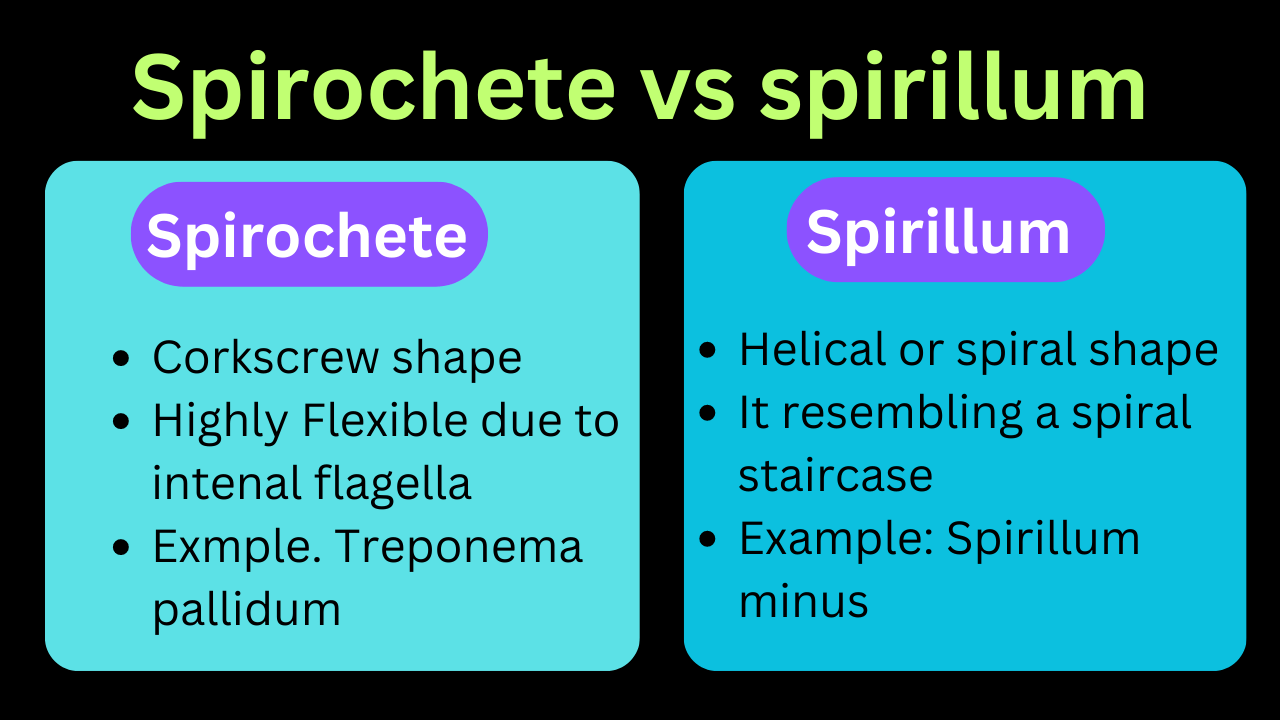Here’s the table of Spirochete vs spirillum with examples.
| Charatristics | Spirochete | Spirillum | |
| 1 | Shape | 1.Corkscrew shape 2. They are highly flexible 3. It can move can move in a corkscrew-like motion due to their internal flagella | 1. It shows distinct helical or spiral shape but appear more rigid compared to spirochetes. 2. It resembling a spiral staircase or a corkscrew. |
| 2 | Motility | It is characterized by a twisting or spiraling motion. | Spirilla are generally motile and possess flagella or polar tufts of flagella |
| 3 | Habitat | Water, soil, and the gastrointestinal tracts of animals. | It is found in aquatic environments, including freshwater and marine habitats |
| 4 | Example | 1. Treponema pallidum 2. Borrelia burgdorferi | 1.Spirillum minus |
A spirochete is a type of bacteria characterized by its unique spiral shape. These bacteria belong to the phylum Spirochaetes and are known for their long, helical (spiral) morphology.
They are highly flexible and can move in a corkscrew-like motion, allowing them to navigate through various environments, including viscous fluids and host tissues.
It has a unique cellular structure and possess internal flagella, called endoflagella, which run along the interior of the cell within the periplasmic space. These endoflagella provide the twisting motion responsible for the spirochetes’ characteristic corkscrew movement.
On the other hand, Spirillum is a genus of bacteria that belongs to the phylum Proteobacteria.
These bacteria are characterized by their helical or spiral-shaped morphology. Unlike spirochetes, which have flexible spirals, spirilla have a more rigid helical shape.
The cells of spirilla are elongated and typically have multiple twists along their length, resembling a spiral staircase or a corkscrew.
What is the Habitats of spirochete?
It is mainly found following places.
- Water: Spirochetes are often present in freshwater and marine environments. They can be found in lakes, rivers, streams, and oceans.
- Soil: Certain species of spirochetes inhabit soil and can play a role in nutrient cycling and decomposition processes.
- Gastrointestinal Tracts: Spirochetes are known to colonize the gastrointestinal tracts of animals, including humans. For example, some species of spirochetes can be found in the oral cavity, intestines, and feces of mammals.
- Insects and Arthropods: Spirochetes can reside in the guts of various insects and arthropods, including ticks and fleas. This association is particularly relevant to the transmission of spirochetal diseases like Lyme disease.
- Host Tissues: Pathogenic spirochetes can establish infection within the tissues of their hosts. For instance, Treponema pallidum, the bacterium responsible for syphilis, can invade various tissues, including the skin, mucous membranes, and internal organs.

